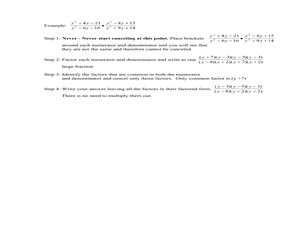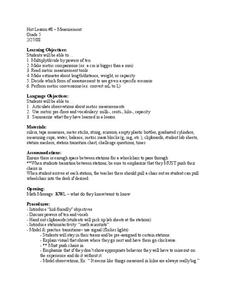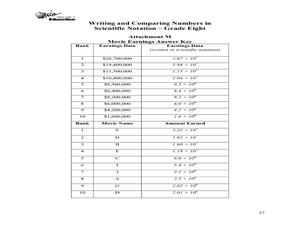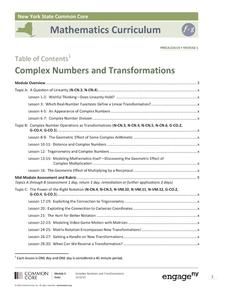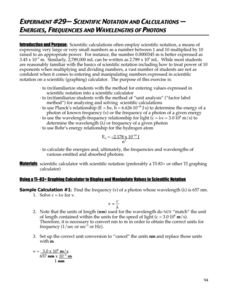Curated OER
Order of Operations Quiz
In this order of operations quiz worksheet, 5th graders solve 25 equations with addition, subtraction, multiplication, division, parentheses and exponents.
Curated OER
Steps and Examples for Multiplying Ratiuonal Expressions
In this multiplying rational expression worksheet, students are given two examples of how to multiply and then simplify rational expressions. The examples are complete with steps and justifications.
Pennsylvania Department of Education
Comparing Sets
Students count back with cubes to model subtraction problems. In this subtraction lesson plan, students compare sets of problems and record their results in a table.
Curated OER
Order of Operations: Pages 19-24
For this math worksheet, students evaluate 15 expressions using the order of operations. Students then evaluate 4 more expressions with given numerical values for variables.
Curated OER
Measurement
Fifth graders complete measurement problems where they use powers of ten, read metric measurement tools, estimate measurements, and more. In this measurement lesson plan, 5th graders complete 10 problems.
Curated OER
Using the Ti-83 Graphing Calculator
For this graphing calculator worksheet, students complete 11 operations on the calculator. Students enter absolute value, exponents, radicals, fractions, mixed numbers, etc.
Curated OER
Logarithms
In this logarithms worksheet, 11th graders solve 10 different problems that include various logarithmic functions. First, they identify a logarithm as the inverse to the exponential function. Then, students calculate the value of each...
Curated OER
Unlocking the Secrets of Math: Simple Steps to Becoming a Better Mathematician
Help your students remember math tricks and rules. Review working with positive and negative numbers, decimals, and the order of operations in this engaging presentation.
Willow Tree
Order of Operations
It's the classic please excuse my dear aunt sally strategy to remembering the order of operations. Young mathematicians practice to develop an understanding of the order of operations. Examples and practice problems include...
Virginia Department of Education
Multiplying Polynomials Using Algebra Tiles
Tiles are not just for algebra—see how they can help with multiplication too. Young mathematicians learn to use algebra tiles to model the multiplication of polynomials. A follow-up worksheet provides practice with the skill.
Ohio Department of Education
Writing and Comparing Numbers in Scientific Notation-Grade Eight
Explore scientific notation in this mathematics lesson. Young mathematicians explore multiple representations of large number in scientific notation through the use of models, visual representation and expanded form. The lesson provided...
Virginia Department of Education
Using Order of Operations and Exploring Properties
If you need some creative ways to teach the order of operations, use a series of activities that focus on properties. Each lesson uses different materials and works as a stand-alone activity, or can build upon the concepts of the last...
EngageNY
Complex Numbers and Transformations
Your learners combine their knowledge of real and imaginary numbers and matrices in an activity containing thirty lessons, two assessments (mid-module and end module), and their corresponding rubrics. Centered on complex numbers and...
Willow Tree
Linear Relationships
There's just something special about lines in algebra. Introduce your classes to linear equations by analyzing the linear relationship. Young mathematicians use input/output pairs to determine the slope and the slope-intercept formula to...
Inside Mathematics
Magic Squares
Prompt scholars to complete a magic square using only variables. Then they can attempt to solve a numerical magic square using algebra.
Code.org
Public Key Cryptography
Investigate how public key cryptography works. Scholars continue their study of one-way functions and asymmetric keys and apply this information to public key cryptography. They use an app to explore public key cryptography and its...
Virginia Department of Education
Adding and Subtracting Polynomials Using Algebra Tiles
Scholars learn how using algebra tiles to add and subtract polynomials can model how to combine polynomials. They use their newfound knowledge to complete a worksheet of problems.
Pingry School
Scientific Notation and Calculations – Energies, Frequencies, and Wavelengths of Photons
The calculator has an interesting way of displaying numbers in scientific notation, but don't let that confuse your pupils! A lesson designed to give learners practice with scientific notation and calculators provides several practice...
Curated OER
Solving Linear Inequalities
Walk the class through the steps of how to evaluate linear inequalities in one variable and graph the solution set. Define and discuss key vocabulary terms, then have individuals work problems of varying difficulty. Included are word...
Curated OER
Newton's Law of Cooling
Your Algebra learners analyze and solve an exponential equation in this popular, real-life model of the cooling of a liquid.
Achieve
BMI Calculations
Obesity is a worldwide concern. Using survey results, learners compare local BMI statistics to celebrity BMI statistics. Scholars create box plots of the data, make observations about the shape and spread of the data, and examine the...
5280 Math
Capture the Points
Play a game of capture the points. Young scholars receive a number line with specific points graphed and must write an inequality that captures all the points. The second task of the algebra project is to write an inequality with...
Curated OER
Linear Equations
In this linear equations worksheet, students solve 9 different linear equations by applying the point-slope formula in each. First, they determine the linear equation of each. Then, students use the slope and one point of the line to...
Teacher Created Resources
PEMDAS: Order of Operations
Learners complete algebraic equations. They learn the algebraic order of operations and the acronym, PEMDAS, to help them remember the correct order of operations. Pupils complete algebraic equations using the order of operations.

